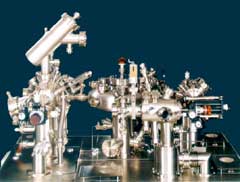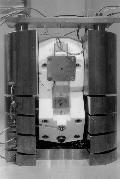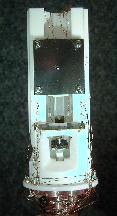| Introduction to STM | Instrumentation | Projects |
| Gallery | Publications | Team |
Instrumentation
NanoLab II
 Our UHV-system bases on an OMICRON Multi-Chamber-System delivered in late 1995. It contains separate chambers for sample distribution, crystal preparation, metal film deposition (MBE chamber), and surface analysis. The central distribution chamber is equipped with an telescope arm which can transport the samples between all satelite chambers. The preparation chamber which is located closest to the observer offers tools for substrate preparation, i.e. e-beam heating, leak valve, and sputter gun. At the right side you may recognize the MBE chamber with up to four e-baem evaporators. Meanwhile this chamber has been replaced by another chamber in order to allow the installation of a homebuild MBE-STM. The analysis chamber contains standard surface analysis tools like LEED, AES, XPS, SP-UPS, as well as a commercial VT-STM. In 1998 another fifth chamber with a homebuild LHe-STM has been added to the system.
Our UHV-system bases on an OMICRON Multi-Chamber-System delivered in late 1995. It contains separate chambers for sample distribution, crystal preparation, metal film deposition (MBE chamber), and surface analysis. The central distribution chamber is equipped with an telescope arm which can transport the samples between all satelite chambers. The preparation chamber which is located closest to the observer offers tools for substrate preparation, i.e. e-beam heating, leak valve, and sputter gun. At the right side you may recognize the MBE chamber with up to four e-baem evaporators. Meanwhile this chamber has been replaced by another chamber in order to allow the installation of a homebuild MBE-STM. The analysis chamber contains standard surface analysis tools like LEED, AES, XPS, SP-UPS, as well as a commercial VT-STM. In 1998 another fifth chamber with a homebuild LHe-STM has been added to the system.
STM development
I. MBE-STM
 This STM is especially suited for the investigation of thin film groth. The basic concept of the microscope is to retract the sample by means of the coarse positioning motor under an angle of 30° with respect to the piezo-tube scanner. This geometric arrangement allows normal film deposition and excludes any interaction between the evaporation beam and the tip. The instrument has the capability of regaining a particular microscopic location on the sample surface with an accuracy of less than 100 nm posterior to a sample displacement of more than 20 mm.
This STM is especially suited for the investigation of thin film groth. The basic concept of the microscope is to retract the sample by means of the coarse positioning motor under an angle of 30° with respect to the piezo-tube scanner. This geometric arrangement allows normal film deposition and excludes any interaction between the evaporation beam and the tip. The instrument has the capability of regaining a particular microscopic location on the sample surface with an accuracy of less than 100 nm posterior to a sample displacement of more than 20 mm.
We have used this STM for the investigation of the room temperature growth of Mn on W(110).
Please click the image for an enlarged representation.
Read the ![]() abstract of the article about the MBE-STM. (Review of Scientific Instruments)
abstract of the article about the MBE-STM. (Review of Scientific Instruments)
II. LHe-STM
 Our new ultra-high vacuum (UHV) scanning tunneling microscope operates at T < 20 K inside the bore of a 2.5 T superconducting split-coil magnet. The tip/sample region can easily be controlled visually, thus allowing safe and fast exchange of samples and tips while the microscope stays at low temperatures. A newly developed rotary motion stepper motor allows rotation of the sample by > 270° about an axis perpendicular to the tip axis. This feature allows metal or molecular beam evaporation normal to the sample surface. Even more important, by means of this device tip and sample can be brought into a parallel or antiparallel magnetic configurationthus opening a novel approach to the study of magnetic phenomena on an atomic length scale. In addition, measurements of the magneto-optical Kerr effect (MOKE) can be carried out without removing the sample from the STM.
Our new ultra-high vacuum (UHV) scanning tunneling microscope operates at T < 20 K inside the bore of a 2.5 T superconducting split-coil magnet. The tip/sample region can easily be controlled visually, thus allowing safe and fast exchange of samples and tips while the microscope stays at low temperatures. A newly developed rotary motion stepper motor allows rotation of the sample by > 270° about an axis perpendicular to the tip axis. This feature allows metal or molecular beam evaporation normal to the sample surface. Even more important, by means of this device tip and sample can be brought into a parallel or antiparallel magnetic configurationthus opening a novel approach to the study of magnetic phenomena on an atomic length scale. In addition, measurements of the magneto-optical Kerr effect (MOKE) can be carried out without removing the sample from the STM.
See more images ![]() of the LHe-STM.
of the LHe-STM.
Read the ![]() abstract of the article about the LHe-STM. (Review of Scientific Instruments)
abstract of the article about the LHe-STM. (Review of Scientific Instruments)
Introduction to STM | Instrumentation | Projects | Gallery | Publications | Team
impressum © copyright 2002 by group R - university of hamburg
